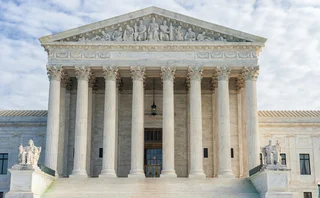US Supreme Court clips SEC’s wings with recent rulings
The Supreme Court made a host of decisions at the start of July that spell trouble for regulators—including the SEC.

Clean air, fishing boats, and truck stops sound more like parts of a summer vacation than anything to do with financial services, but these are the root issues of a few US Supreme Court judgements that have piled pressure on the Securities and Exchange Commission (SEC).
In early July, the Supreme Court made a series of decisions designed to curb administrative overreach of the country’s regulatory bodies. This included the landmark decision to end the so-called Chevron deference, a 40-year precedent that said courts should defer to regulators on specific interpretations of congressional legislation—a “leave it to the experts” approach that has been much maligned by conservative voices in recent years.
Along with the decision to overturn Chevron, the Supreme Court ruled on two more cases: Securities and Exchange Commission v. Jarkesy, and Corner Post, Inc. v. Board of Governors of the Federal Reserve System, both of which have direct impacts on how the SEC will bring enforcement cases against firms. WatersTechnology spoke to several law firms, compliance experts, and former SEC staff in the US to understand the impact these decisions have on how the SEC functions, and whether it jeopardizes the regulator’s ability to police the capital markets.
Chevron came into effect in 1984 as the result of a legal challenge to the 1963 Clean Air Act. An environmentalist advocacy group sued the Environmental Protection Agency and won in federal court, but the Supreme Court overturned the decision, ruling that courts should broadly defer to independent regulatory authorities.
Courts have been trying to put some of the federal agencies back in their box a little bit
Kevin Harnisch, Norton Rose Fulbright
The case that overturned the Chevron doctrine also came from an unlikely source. Fishing and seafood company Loper Bright challenged a rule issued by the National Marine Fisheries Service requiring fishing companies to pay for the cost of federal monitors attached to their boats. The Court sided with the fishing company.
Kevin Harnisch is head of white collar defense and investigations at US law firm Norton Rose Fulbright. He worked at the SEC in the enforcement division before moving to a law firm, Fried Frank, in 2004, where he spent almost 15 years working in white collar and securities enforcement law. When he joined Norton Rose Fulbright, it was as head of SEC enforcement.
Having experienced the SEC both from within and outside the regulator, Harnisch believes that recent increased pressure on regulators like the SEC stems from a constantly shifting ebb and flow over the perception of administrative roles in the US.
“I think with a lot of the rule-making that it’s really been like a pendulum over time,” he says. “Under the Chevron doctrine, the pendulum had swung heavily in favor of agencies having the ultimate word on ambiguous statutory provisions, but I would say over the last several years that that position has been starting to moderate. If you look at a lot of court decisions, courts have been trying to put some of the federal agencies back in their box a little bit.”
Another key decision made in July was on SEC v. Jarkesy. Jarkesy stems from the aftermath of the 2008 financial crisis, when the Dodd–Frank Act gave the SEC the authority alongside federal courts to impose civil penalties on firms and individuals facing enforcement actions. The SEC has traditionally adjudicated cases like these through internal administrative law judges (ALJs), rather than take cases through the federal court system, but the Court recently ruled this practice violates the Seventh Amendment, which ensures the right to a jury trial in civil cases. ALJ courts do not have juries, and the Supreme Court decided in early July that those charged with civil penalties by the SEC have the right to a jury trial.
The rulings on Jarkesy and Chevron stand to affect SEC enforcement processes in the capital markets. The SEC is likely to pursue more cases in federal court instead of using its own judges as a result of the Jarkesy decision, says Harnisch, who believes that while this may not impact the SEC’s desire to bring aggressive cases, they will need to be more discerning in deciding which cases to pursue.
“What they’ll often do in an enforcement context, where they’re looking at something in a new or cutting-edge area, is look for that right factual situation that they think will make a case very appealing to a judge,” he says.
The Jarkesy decision also calls into question the constitutionality of the agency’s use of administrative proceedings for certain cases, specifically those involving fraud, a crime where a jury would traditionally reach a verdict.
A spokesperson for the SEC referred WatersTechnology to a statement by the SEC’s director of the division of enforcement, Gurbir Grewal, from the day of the Jarkesy decision: “The SEC will continue to protect investors and enforce the federal securities laws, including by filing actions in federal court. Indeed, during the last several years, the SEC has successfully enforced the federal securities laws in federal court, obtaining favorable jury verdicts and dispositive motion rulings in highly contested matters with industry-wide implications.”
The spokesperson also referred to a public SEC document that showed that between October 2023 and March 2024, there were only two matters pending before the ALJs, while there were nine matters facing ALJs between October 2022 and March 2023.
Additionally, Bloomberg Law reported that between July 2015 and July 2023, the number of in-house SEC proceedings before an ALJ shrank from a high of 60 to five or fewer.
Regarding the Chevron and Corner Post decisions, the SEC declined to comment.
Jennifer Schulp, director of financial regulation studies at libertarian think tank Cato Institute’s Center for Monetary and Financial Alternatives, says these decisions complicate internal enforcement calculations at the SEC.
“The SEC is not as successful in court, and it is a much heavier administrative burden internally for the SEC to bring a case in court rather than their own administrative law judges,” she says. “One of the ways that agencies might want to avoid [the implications of] Loper Bright is by trying to get parties to settle with them and thus avoid the courts. But Jarkesy changes the settlement calculus a bit, so there are a lot of moving pieces.”
Schulp says the SEC’s reach has been under the microscope for some time, and cites last year’s proposed predictive data analytics rule as an example of the regulator overstepping its bounds. However, the Commission’s regulatory agenda indicates that the rule will be re-proposed.
“When the SEC put forward the predictive data analytics proposal a year ago, which they claimed was AI-focused, I think it was already well outside the bounds of what the SEC had the authority to do,” she says. “Not because it was AI, but because the SEC was reaching too far in terms of its existing authority.”
A soft landing?
While overturning Chevron is a significant blow, how it immediately impacts the SEC is harder to define. As a government regulator, the Commission could benefit from the precedent, but the number of cases it applied to has dwindled in recent years.
David Fredrickson, senior counsel for securities and capital markets at law firm Covington and Burling, spent almost three decades working at the SEC in various roles, including as an enforcement attorney and chief counsel of the corporation finance division. He believes that in his experience, Chevron’s loss will not hurt the regulator’s ability to bring enforcement actions.
“I don’t think [Chevron’s overturning] is going to have much, if any, effect on the SEC,” he says. “Chevron has not figured all that prominently in the cases that are brought against the SEC. The Supreme Court majority is definitely saying to the courts that they are in charge of deciding what the law is here, and ‘We’ve got your back.’”

On the Jarkesy decision, Fredrickson takes a contrarian view. He says that in like cases applicable to Chevron, the SEC has also dialed back its number of ALJ cases over the last six or seven years, in anticipation of its powers being stripped back. He says that the SEC’s high settlement rate in its ALJ cases is more a question of psychology.
“A feature of the SEC enforcement program is because they can bring an action in district court or bring in an action in administrative proceeding, there’s always been this perception that the administrative proceeding is less severe, so part of negotiating settlements for many companies is, ‘We’ll agree to X—whatever the violation—as long as we can settle in an administrative forum,’” he says. “There’s a built-in bias that there is a high number of settlements in the administrative forum because that’s more efficient for the SEC, and it seems less severe than settling to a district court action.”
On whether the Jarkesy decision will see parties who have already been judged by an ALJ start making appeals, Fredrickson points out that the SEC’s aggressive and wide-ranging rulemaking agenda has already triggered a number of legal battles over the regulator’s perceived overreaches.
Cato’s Schulp says that while the immediate impacts of Chevron and Jarkesy are not going to be backbreaking, that is not the point of the Supreme Court’s decision.
“This is not a slam dunk that suddenly means agencies are going to be hamstrung. In fact, I’m not terribly interested in completely hamstringing the SEC; I would just like it to be doing its job within what Congress has told it to do,” she says.
Litigation stations
If the SEC was fazed by the decisions made by the Supreme Court, it has not shown it. According to the Commission’s website, the SEC has brought 17 complaints between July 1 and July 30, reflecting that its attitude to enforcement remains as enthusiastic as before.
Paul Cottee, director of regulatory compliance at market surveillance specialist Nice Actimize, says that through paring back perceived SEC overreach through Chevron, the Supreme Court has increased pressure on the regulator and emboldened aggrieved parties considering or actively pursuing suits against the SEC, which will increase its caseload.
He agrees with Schulp’s view that the SEC should have been expecting its powers to be limited for some time now. He says that the regulator is unlikely to have been caught off-guard by the decisions and would have been “war-gaming” potential outcomes of the decisions. Now that they’ve been made, Cottee foresees an increase in courtroom litigation.
“These decisions together upend the way that the administrative state has worked for the last 40 years, so we’re probably going to see a lot more litigation in the federal court system in general,” he says.
Cottee, who worked at Nasdaq’s market abuse software team, Smarts, before joining Nice Actimize, explains that legal fees and budgets are also factors the SEC must consider before pursuing enforcement actions, now that it cannot use ALJs to process certain cases.
“These agencies have got a budget, and they will have to determine which [cases] they think are worth bringing—that are going to get the most bang for their buck,” he says. “The SEC might review some cases that it now has to bring in federal courts and say, ‘Well, you know what? What do we think our chances of success are with this particular case in front of a federal court?’ So, they may decide to not litigate.”
Another example of the pendulum swinging away from regulators came with the Supreme Court’s decision on Corner Post, Inc. v. Board of Governors of the Federal Reserve System on July 1. Corner Post, a truck stop in North Dakota, had sued the Federal Reserve, arguing the interchange fee that it charges customers for using debit cards is too expensive.
The cap on the fee was decided in 2011, and had a six-year statute of limitations, wherein companies could appeal the ruling. Corner Post opened its doors in 2017 and brought the suit against the Fed anyway, arguing that the clock on the statute of limitations only began from when Corner Post was incorporated. The Supreme Court sided with the truck stop, which means that any agency rule can be challenged if it continues to harm business in the present day, including the SEC’s rules.
For Covington’s Fredrickson, this ruling was a surprise.
“[Corner Post] is to me, right out of the blue,” he says. “That is a real game-changer. No rule is ever settled, and new entrants into the marketplace can say, ‘I’m affected. I can bring an action against it.’ So that is quite destabilizing.”
Fredrickson explains that in practice, this ruling means that if a law passed in the 1960s is affecting a company founded in 2019, the owner of that company can bring a challenge against the regulator.
“I don’t know that anyone saw that coming,” he says.
Cato’s Schulp thinks that while there may be difficult times on the horizon for the SEC, decisions like this are ultimately a step in the right direction.
“My general take about all of this is that we’re going to have a rocky few years while this gets sorted out,” she says. “We’re going to have people suing. We might have some more aggressive suits on rulemaking, but I think that at the end of the day, this all bodes well for agencies taking a more restrained view of their congressionally delegated authority.”
Further reading
Only users who have a paid subscription or are part of a corporate subscription are able to print or copy content.
To access these options, along with all other subscription benefits, please contact info@waterstechnology.com or view our subscription options here: http://subscriptions.waterstechnology.com/subscribe
You are currently unable to print this content. Please contact info@waterstechnology.com to find out more.
You are currently unable to copy this content. Please contact info@waterstechnology.com to find out more.
Copyright Infopro Digital Limited. All rights reserved.
As outlined in our terms and conditions, https://www.infopro-digital.com/terms-and-conditions/subscriptions/ (point 2.4), printing is limited to a single copy.
If you would like to purchase additional rights please email info@waterstechnology.com
Copyright Infopro Digital Limited. All rights reserved.
You may share this content using our article tools. As outlined in our terms and conditions, https://www.infopro-digital.com/terms-and-conditions/subscriptions/ (clause 2.4), an Authorised User may only make one copy of the materials for their own personal use. You must also comply with the restrictions in clause 2.5.
If you would like to purchase additional rights please email info@waterstechnology.com
More on Regulation
Off-channel messaging (and regulators) still a massive headache for banks
Waters Wrap: Anthony wonders why US regulators are waging a war using fines, while European regulators have chosen a less draconian path.
Banks fret over vendor contracts as Dora deadline looms
Thousands of vendor contracts will need repapering to comply with EU’s new digital resilience rules
Chevron’s absence leaves questions for elusive AI regulation in US
The US Supreme Court’s decision to overturn the Chevron deference presents unique considerations for potential AI rules.
Aussie asset managers struggle to meet ‘bank-like’ collateral, margin obligations
New margin and collateral requirements imposed by UMR and its regulator, Apra, are forcing buy-side firms to find tools to help.
The costly sanctions risks hiding in your supply chain
In an age of geopolitical instability and rising fines, financial firms need to dig deep into the securities they invest in and the issuing company’s network of suppliers and associates.
Industry associations say ECB cloud guidelines clash with EU’s Dora
Responses from industry participants on the European Central Bank’s guidelines are expected in the coming weeks.
Regulators recommend Figi over Cusip, Isin for reporting in FDTA proposal
Another contentious battle in the world of identifiers pits the Figi against Cusip and the Isin, with regulators including the Fed, the SEC, and the CFTC so far backing the Figi.
This Week: FCA, Plato/Turquoise, Franklin Templeton, and more
A summary of the latest financial technology news.








